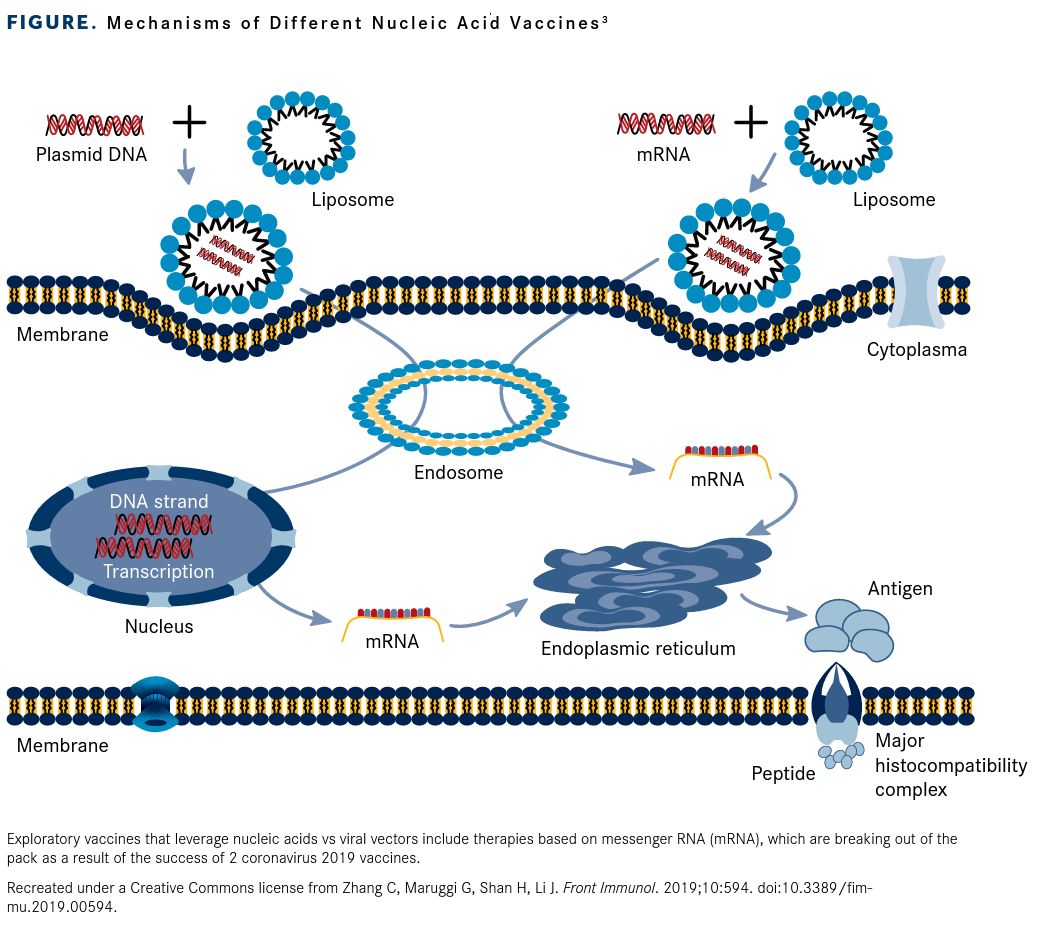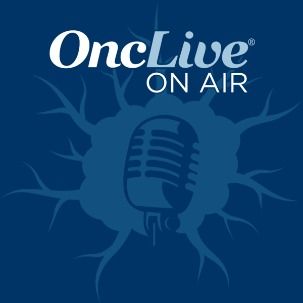Publication
Article
Oncology Live®
COVID-19 Jumpstarts RNA Cancer Vaccine Field
Author(s):
The success of the COVID-19 vaccines based on messenger RNA has led to a surge of interest from investigators, pharmaceutical companies, and investors in similar technology for other diseases, including a number of oncology indications.
Timothy A. Chan, MD, PhD

The success of the COVID-19 vaccines based on messenger RNA has led to a surge of interest from investigators, pharmaceutical companies, and investors in similar technology for other diseases, including a number of oncology indications. Experts say approved mRNA therapies for cancer are still years away, but several vaccines for melanoma and other malignancies are being evaluated in phase 2 trials and many others are in phase 1 or preclinical development.
Therapeutic cancer vaccines, which train the immune system to recognize tumor-associated antigens, have been studied for decades and 2 have FDA approval: BCG vaccine, a weakened bacteria used for early-stage bladder cancer, and sipuleucel-T (Provenge), a treatment for asymptomatic or minimally symptomatic metastatic castration-resistant prostate cancer that involves ex vivo activation of autologous dendritic cells.1 Talimogene laherparepvec (T-VEC; Imlygic), an oncolytic virus therapy approved for local treatment of lesions in patients with recurrent melanoma, also is sometimes described as a cancer vaccine.2
Immunologists have tried to create vaccines using a variety of experimental platforms. These include whole cell–based and virus-based vaccines, and molecular vaccines that use DNA, RNA, or peptides that encode anti-gens to activate immune responses against tumor cells (FIGURE3). The advantages of RNA vaccines include the ability to stimulate an innate immune response through a comparatively simple and rapid process; disadvantages involve concerns over instability and low immunogenicity.3
Although vaccines based on mRNA technology have been explored during the past 20 years, the FDA’s emergency use authorization of the COVID-19 vaccines has served as a proof of concept. BNT162b2 developed by Pfizer-BioNTech and mRNA-1273, from Moderna, Inc are nucleoside-modified mRNA vaccines that encode the prefusion spike glycoprotein of severe acute respiratory syndrome coronavirus 2, which causes COVID-19. Both are encapsulated within lipid nanoparticles.4
Timothy A. Chan, MD, PhD, director of the Center for Immunotherapy and Precision Immuno-Oncology at the Lerner Research Institute at Cleveland Clinic in Ohio, studies RNA but said until recently he had seen it as just another vaccine technology that had yet to yield an approved product.
“Prior to the phase 3 [trials] for COVID-19, nobody was thinking about RNA as a serious player, really. As of 2019, I had never thought too much about RNA. I just thought it was one of those vectors. Nobody was using it,” said Chan, whose research helped identify neoantigens as the targets for vaccines and other immunotherapies.5 “COVID-19 actually accelerated the RNA field.”
Drew Weissman, MD, PhD

Chan, a cofounder of the RNA vaccine developer Gritstone Oncology, Inc, said he now expects that hundreds of new companies focusing on RNA will spring up in the near future. Drew Weissman, MD, PhD, an immunologist at the University of Pennsylvania in Philadelphia who discovered the nucleoside modifications that allow use of RNA in vaccines,6 said he’s been receiving calls from venture capitalists who want to start biotech companies to explore uses for RNA-based technology. Herbert Kim Lyerly, MD, director of the Center for Applied Therapeutics at Duke University School of Medicine in Durham, North Carolina, said that last year he was able to set up a new company, Replicate Biosciences, Inc, thanks in part to funders’ new enthusiasm for RNA technology.
It has helped investigators to have “the idea of an mRNA vaccine be seen as a success,” said Lyerly, who also is the George Barth Geller Distinguished Professor of Immunology at Duke. The COVID-19 vaccines, he noted, are the fruit of many years of painstaking study. “It’s not like RNA vaccines were completely unheard of, and then COVID-19 came and they sprang out of nothing,” he said. “You prepare your whole life to be an overnight success.”
Scientists at BioNTech SE and Moderna, Inc were able to design anti–COVID-19 products quickly after spending years working on RNA-based agents to prevent or treat cancers, HIV, influenza, genetic disorders, and other conditions. Before the pandemic, BioNTech focused primarily on oncology, developing investigational therapies for melanoma, triple-negative breast cancer, human papillomavirus (HPV)–driven head and neck cancer, lung cancer, and KRAS-mutated solid tumors.
RNA vaccines for melanoma therapies are among the most advanced in oncology, but many other tumors could prove responsive to treatments based on the platform, said Ezra Cohen, MD, FRCPSC, FASCO, associate director for translational science and leader of the solid tumor therapeutics research program at Moores Cancer Center at the University of California San Diego.
“Melanoma is inherently a more immune-responsive cancer, so I wouldn’t be surprised if we see data on melanoma early. The tumors where we’re seeing success using PD-1 or PD-L1 inhibitors are likely to be the first ones to have success with RNA vaccines,” said Cohen, who also is chief of the Division of Hematology-Oncology at Moores. “With a vaccine, we’re trying to activate specific T cells. In highly immunosuppressed cancers like pancreatic cancer, where it’s very difficult for T cells to get into the tumor, we will see vaccines being tried and successful later.”
FIGURE. Mechanisms of Different Nucleic Acid Vaccines

INDUSTRY FOCUS TURNS TO RNA IN CANCER
BioNTech Efforts
Melanoma was the target in BioNTech’s phase 1 Lipo-MERIT trial (NCT02410733) in patients with stage IIIB to C and stage IV melanoma. The first-in-human study tested the mRNA vaccine BNT111, which is based on the company’s off-the-shelf FixVac platform and is composed of 4 nonmutant shared tumor–associated melanoma antigens (NY-ESO-1, MAGE-A3, tyrosinase, and TPTE). The therapy was well tolerated with no dose-limiting toxicity, according to interim data published in Nature in 2020. In a safety assessment of 89 patients with advanced unresectable melanoma treated with intravenously delivered repeated doses ranging from 7.2 µg to 400 µg, the most common adverse events (AEs) were mild-to-moderate, transient flu-like symptoms such as pyrexia and chills.7,8
A subset of 42 patients with radiologically evaluable melanoma after prior treatment with checkpoint inhibitors was assessed by imaging of metastatic lesions before and after vaccination. Of 25 patients treated with BNT111 monotherapy, 3 experienced a partial response (PR), 7 showed stable disease (SD), and 1 had complete metabolic remission of metastatic lesions. Of 17 patients treated with BNT111 plus anti-PD-1 therapy, 6 developed a PR. Treatment with BNT111 also resulted in the expansion and activation of CD4-positive and CD8-positive T cells that complement the activity of anti–PD-1/PD-L1 therapy, investigators noted. The vaccine “ramped-up” antigen-specific T cells of the effector memory phenotype, which is of importance for cell-mediated immune responses such as activation of antigen-specific cytotoxic T cells.7,8
Herbert Kim Lyerly, MD

Investigators also are testing RO7198457 (BNT122), a personalized mRNA vaccine that contains up to 20 patient-specific neoantigens, as monotherapy and in combination with PD-1/PD-L1 pathway inhibitors. BioNTech is developing the individualized neoantigen-specific immunotherapy platform in collaboration with Genentech.9,10
Findings from the first-in-human, ongoing phase 1a/1b basket study (NCT03289962) of RO7198457 as monotherapy and in combination with atezolizumab (Tecentriq), a PD-L1 inhibitor, were presented at the 2020 American Association for Cancer Research Virtual Annual Meeting II. The study is recruiting patients with locally advanced or metastatic solid tumors, including melanoma, non–small cell lung cancer (NSCLC), bladder cancer, and colorectal cancer.9,10
In the phase 1a dose-escalation phase, 31 patients who had undergone a median of 5 lines of prior therapies (range, 1-17) received RO7198457 at doses ranging from 25 µg to 100 µg. Of 26 patients with at least 1 tumor assessment, 1 patient with gastric cancer and metastatic liver lesions had a confirmed complete response (CR) that was ongoing for more than 10 months at the time of the presentation, and 12 participants had SD. Neoantigen-specific T-cell responses were generated in the peripheral blood of 86% of patients.9
In the phase 1b portion of the study, 132 patients received the vaccine in combination with atezolizumab at doses ranging from 15 µg to 50 µg. Of 108 patients with at least 1 tumor assessment, 1 patient had a CR as best response (0.9%), 8 had PRs (7.4%), and 53 had SD (49.1%). T-cell responses were observed in nearly 73% of 63 patients evaluated.10
The combination was well tolerated, investigators said. The majority of AEs were of grade 1 or 2 severity, mostly transient systemic reactions including infusion-related reactions, cytokine release syndrome, and influenza-like illness. No dose-limiting toxicities were observed.10
In another novel regimen involving the mRNA vaccine, the combination of RO7198457 plus pembrolizumab (Keytruda) is being evaluated vs pembrolizumab alone in patients with previously untreated advanced melanoma in the phase 2 IMCODE001 trial (NCT03815058). Investigators plan to enroll 132 participants and complete the trial by September 2022.
Moderna Studies
Beyond its COVID-19 vaccine, Moderna also is developing anticancer mRNA vaccines with diverse mechanisms of action. The most advanced in terms of the company’s clinical pipeline are mRNA-4157, a personalized vaccine that can encode up to 34 neoantigens, and mRNA-2416, an intratumoral therapy that encodes for the OX40L immune stimulator.11-13
The mRNA-4157 vaccine is being tested in combination with pembrolizumab in patients with unresectable solid tumors in the phase 1 KEYNOTE-603 study (NCT03313778). Updated findings from part C of the study involving 10 patients with HPV-negative head and neck squamous cell carcinoma (HNSCC) and 17 participants with microsatellite- stable colorectal cancer (MSS-CRC) who had not been previously treated with checkpoint inhibitors were presented at the Society for Immunotherapy of Cancer 35th Anniversary Annual Meeting & Preconference Programs in November 2020.12
Ezra Cohen, MD, FRCPSC, FASCO

In the HNSCC group, the overall response rate (ORR) as measured by RECIST 1.1 was 50% (5 of 10 patients), with 2 participants achieving CR with no detectable disease and 3 achieving PR, all of which were ongoing. Median progression-free survival (PFS) was 9.8 months, comparing favorably to published ORR and median PFS of 14.6% and 2 months, respectively, for pembrolizumab monotherapy in HNSCC. Including 4 patients with SD, the disease control rate was 90% (9 of 10 patients). Median duration of response had not been reached. Based on the interim data, investigators recommended expanding the cohort.12
However, no responses and 1 SD were observed among participants with MSS-CRC. Ten of the patients with MSS-CRC progressed rapidly within 6 weeks of receiving the vaccine, and only 1 completed all doses. Investigators theorized that most of the MSS-CRC tumors were “immunologically cold,” as measured through gene expression profile and cytolytic activity scores.12
The efficacy of mRNA-4157 is being explored in the phase 2 KEYNOTE-942 trial (NCT03897881) in combination with pembrolizumab vs pembrolizumab alone in patients with cutaneous melanoma who have undergone complete resection and are deemed at high risk of recurrence.
Meanwhile, mRNA-2416 is being evaluated as monotherapy and in combination with durvalumab (Imfinzi), a PD-L1 inhibitor, in patients with relapsed or refractory advanced solid tumors or lymphoma in an ongoing phase 1/2 trial (NCT03323398). Patients with ovarian cancer are eligible for the combination arm.
In data from the monotherapy arm of the study, mRNA-2416 was generally well tolerated with no dose-limiting toxicities. Of 39 patients with advanced cancers who received the vaccine, 7 experienced grade 3 treatment-related AEs. The best overall response was SD by RECIST criteria in 14 patients, including 6 who maintained SD for at least 14 weeks. Among 6 participants with ovarian cancer, 4 had SD.13
In terms of biomarkers, the vaccine therapy resulted in an increase of the OX40L protein and T-cell infiltration in the tumor microenvironment, which investigators said were beneficial signals that warrant further study.13
Additional Vaccines
Research also is moving forward on other fronts. Gritstone Oncology is conducting phase 2 trials of a personalized RNA product, GRANITE, with 20 tumor-specific neoantigens, and an off-the-shelf shared neoantigen therapy, SLATE, that includes 20 driver mutations.
In early findings involving 10 patients, GRANITE showed good tolerability and strong, consistent induction of killer CD8-positive T cells specific to multiple neoantigens that accumulated in tumors, the company said. The phase 2 portion of the GO-004 study (NCT03639714) has been expanded to include cohorts for patients with MSS-CRC and gastroesophageal cancer who have progressed on chemotherapy regimens. The vaccine is administered in combination with the immune checkpoint inhibitors nivolumab (Opdivo) and ipilimumab (Yervoy).14,15
SLATE also demonstrated strong induction of CD8-positive T cells but more consistently against multiple KRAS mutations, the company said. The phase 2 portion of the GO-005 study (NCT03953235) is recruiting patients with NSCLC harboring KRAS mutations who have progressed on prior checkpoint inhibitor therapy and patients with TP53-mutated advanced cancers. Participants also will receive combination immunotherapy with nivolumab plus ipilimumab.14,15
Other companies working on RNA-based immunotherapies include Immunomic Therapeutics, Inc, which is conducting the phase 2 ATTAC-II trial (NCT02465268) testing its mRNA vaccine ITI-1000 in patients with newly diagnosed glioblastoma. The vaccine targets malignant glial cells expressing the cytomegalovirus pp65 protein.
Academic efforts include a phase 1 trial (NCT04573140) of RNA-lipid particle vaccines for newly diagnosed pediatric high-grade gliomas and adult glioblastoma launched by Elias Sayour, MD, PhD, a pediatric oncologist at the University of Florida.16
TECHNOLOGICAL CHALLENGES
RNA’s advantages are the speed and relative ease of creating a customized neoantigenic cassette and the large number of targets that can be included. “You can load a tremendous amount of code so that your manufacturing costs are a fraction of what they would be if you were using a peptide vaccine,” Cohen said. “You basically just have to make 1 string of RNA, as opposed to a peptide vaccine where you have to make each peptide individually.”
RNA thus lends itself to making cancer vaccines, which sometimes target 20 or 30 different proteins. However, identifying the antigens that will stimulate the most effective immune response remains a major challenge, as shown by the slow pace of vaccine development progress so far, experts say.
One question is whether to make a personalized vaccine that targets unique “private” antigens found in each patient’s individual tumor or an off-the-shelf shared vaccine directed at mutations commonly found in a particular tumor type. Philosophies about the best approach vary. “We’ve taken the approach that the individualized vaccines are going to be more efficacious because that’s really what cancer is: Every cancer is unique. And we need to address that,” Cohen said. “Having said that, you can still f ind commonality among those unique mutations. You can imagine a hybrid approach, a vaccine that has some shared antigens while the personalized ones are being discovered and manufactured.”
Lyerly prefers to target known shared alterations that drive tumor behavior, such as mutations in PI3K or estrogen receptors, so that the patient benefits when the mutation is lost during evolved resistance. “We have 2 ways of winning: You get an antigen loss variant, or you kill the cell,” he said. By contrast, private antigens are often inessential. “If you lost the rearview mirror on your car when you’re escaping, it doesn’t really matter that much. But if you lose your drive train, it does matter,” he said.
Perfecting individualized vaccines will also require better identification of the most useful neoantigens. Cohen said computer algorithms for predicting effectiveness are wrong much of the time and can only identify proteins from human leukocyte antigen class 1, not class 2. Chan said current algorithms are “not bad,” as studies have found that more than 80% of their predicted targets induce T cells. But both Cohen and Chan said they expect algorithms will improve as more data are known. They noted that traditional immunology using functional T-cell assays is accurate, though laborious.
Eventually, both methods will be superseded by more advanced proteomic approaches, Cohen said. “They’re not sensitive enough, but we’re getting there. Within a few years, certainly within a decade, you can imagine we’ll just be able to interrogate the peptide sequence within the MHC [major histocompatibility complex]. We won’t need algorithms. We won’t need T-cell assays. We’ll just go right to the source,” he said.
Chan, Lyerly, and others also said future vaccines will use self-amplifying RNA (saRNA), which requires vastly smaller doses than the modified RNA in the COVID-19 vaccines, lowering production costs. Chan argued that saRNA is also “completely natural,” unlike chemically modified RNA, and thus less likely to be mutagenic. (Gritstone’s investigational vaccines use saRNA.) Weissman, who discovered modified RNA, said saRNA’s role remains unclear; he said the cost savings are not significant and noted that BioNTech trialed an saRNA COVID-19 vaccine but found that the modified RNA version was more effective.
Weissman also said studies have found that saRNA leads to greater protein production but from many fewer cells than modified RNA. Lyerly countered that that finding would be a good sign, as delivery into cells can be improved by changing the vaccine’s lipid shell formulation.
References
- Cancer vaccines: preventive, therapeutic, personalized. Cancer Research Institute. Accessed March 23, 2021. https://bit.ly/3tMnx9R
- Cancer treatment vaccines. National Cancer Institute. September 24, 2019. Accessed March 23, 2021. https://bit.ly/3lEWdaU
- Zhang C, Maruggi G, Shan H, Li J. Advances in mRNA vaccines for infectious diseases. Front Immunol. 2019;10:594. doi:10.3389/fimmu.2019.00594
- Vaccine FAQ. COVID-19 Real Time Learning Network. Updated March 5, 2021. Accessed March 23, 2021. https://bit.ly/39akZKV
- Rizvi NA, Hellmann MD, Snyder A, et al. Cancer immunology. mutational landscape determines sensitivity to PD-1 blockade in non-small cell lung cancer. Science. 2015;348(6230):124-128. doi:10.1126/science.aaa1348
- Paving the way for a COVID-19 vaccine: a conversation with Dr. Drew Weissman. Penn Medicine. December 11, 2020. Accessed March 23, 2021. https://bit.ly/3lHd7FM
- Sahin U, Oehm P, Derhovanessian E, et al. An RNA vaccine drives immunity in checkpoint-inhibitor-treated melanoma. Nature. 2020;585(7823):107-112. doi:10.1038/s41586-020-2537-9
- BioNTech publishes data from mRNA-based BNT111 FixVac melanoma trial in Nature. News release. BioNTech SE. July 30, 2020. Accessed March 12, 2021. https://investors.biontech.de/news-releases/news-release-details/biontech-publishes-data-mrna-based-bnt111-fixvac-melanoma-trial
- Braiteh F, LoRusso P, Balmanoukian A, et al. A phase Ia study to evaluate RO7198457, an individualized neoantigen specific immunotherapy (iNeST), in patients with locally advanced or metastatic solid tumors. Cancer Res. 2020;80(suppl 16):CT169. doi:10.1158/1538-7445.AM2020-CT169
- Lopez JS, Camidge R, Iafolla M, et al. A phase Ib study to evaluate RO7198457, an individualized neoantigen specific immunotherapy (iNeST), in combination with atezolizumab in patients with locally advanced or metastatic solid tumors. Cancer Res. 2020;80(suppl 16):CT301. doi:10.1158/1538-7445.AM2020-CT301
- Moderna’s pipeline. Moderna Inc. Accessed March 12, 2021. https://www.modernatx.com/pipeline
- Bauman J, Burris H, Clarke J, et al. Safety, tolerability, and immunogenicity of mRNA-4157 in combination with pembrolizumab in subjects with unresectable solid tumors (Keynote-603): an update. J Immunother Cancer. 2020;8(suppl 3):798. doi:10.1136/jitc-2020-SITC2020.0798
- Jimeno A, Gupta S, Sullivan R, et al. A phase 1/2, open-label, multicenter, dose escalation and efficacy study of mRNA-2416, a lipid nanoparticle encapsulated mRNA encoding human OX40L, for intratumoral injection alone or in combination with durvalumab for patients with advanced malignancies. Cancer Res. 2020;80(suppl 16):CT032. doi:10.1158/1538-7445.AM2020-CT032
- Gritstone corporate presentation. Gritstone Oncology Inc. March 2021. Accessed March 24, 2021. https://ir.gritstoneoncology.com/static-files/15857056-7494-41ed-ace0-44026e604210
- Gritstone Oncology advances into phase 2 expansion cohorts for its personalized neoantigen immunotherapy GRANITE and its off-the-shelf neoantigen immunotherapy SLATE. News release. Gritstone Oncology Inc. November 2, 2020. Accessed March 23, 2021. https://bit.ly/3d3Cs8R
- Jaffee M. UF brain tumor researcher embarks on first-in-human clinical trial of novel immunotherapy vaccine. News release. University of Florida Health. March 30, 2020. Accessed March 12, 2021. https://bit.ly/2OU3I1R



























%20(2)%201-Recovered-Recovered-Recovered-Recovered-Recovered-Recovered-Recovered-Recovered-Recovered-Recovered-Recovered-Recovered-Recovered-Recovered-Recovered-Recovered-Recovered.jpg?fit=crop&auto=format)
%20(2)%201-Recovered-Recovered-Recovered-Recovered-Recovered-Recovered-Recovered-Recovered-Recovered-Recovered-Recovered-Recovered-Recovered-Recovered-Recovered-Recovered-Recovered.jpg?fit=crop&auto=format)
